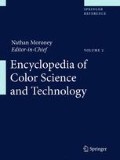References
Ratliff, F., Hartline, H.: The responses of Limulus optic nerve fibers to patterns of illumination on the receptor mosaic. J. Gen. Physiol. 42, 1241–1255 (1959)
von Bekesy, G.: Mach- and Hering-type lateral inhibition in vision. Vision Res. 8, 1483–1499 (1968)
Davidson, M.: A perturbation analysis of spatial brightness interaction in flashed visual fields. Ph.D. dissertation (unpublished). University of California, Berkeley (1966)
Fiorentini, A.: Foveal and extra foveal contrast threshold data point of a non uniform field. Atti delta Fondazione Giorgio Ronchi 12, 180–186 (1957)
Heinemann, E.: Simultaneous brightness induction. In: Jameson, D., Hurvich, L. (eds.) Handbook of Sensory Physiology, vol. VII-4, pp. 146–169. Springer, Berlin (1972)
Ratliff, F.: Why Mach bands are not seen at the edges of a step? Vision Res. 24, 163–165 (1984)
Ross, J., Morrone, M., Burr, D.: The conditions under which Mach bands are visible. Vision Res. 29, 699–715 (1989)
Morrone, M., Ross, J., Burr, D., Owens, R.: Mach bands depend on spatial phase. Nature 324, 250–253 (1986)
Syrkin, G., Yinon, U., Gur, M.: Simple cells may be the physiological basis of the Mach band phenomenon: evidence from early monocularly deprived cats. Soc. Neurosci. Abstr. 20, 312 (1994)
Tolhurst, D.: On the possible existence of edge detector neurons in the human visual system. Vision Res. 12, 797–804 (1972)
Morrone, M., Burr, D.: Feature detection in human vision: a phase-dependent energy model. Proc. R. Soc. Lond. B 235, 221–245 (1988)
Watt, R., Morgan, M.: A theory of the primitive spatial code in human vision. Vision Res. 25, 1661–1674 (1985)
Fiorentini, A., Baumgartner, G., Magnussen, S., Schiller, P., Thomas, J.: The perception of brightness and darkness: relations to neuronal receptive fields. In: Spillmann, L., Werner, J. (eds.) Visual Perception: The Neurophysiological Foundations, pp. 129–161. Academic, San Diego (1990)
du Buf, J.: Ramp edges, Mach bands, and the functional significance of the simple cell assembly. Biol. Cybern. 69, 449–461 (1994)
Kingdom, F., Moulden, B.: A multi-channel approach to brightness coding. Vision Res. 32, 1565–1582 (1992)
Pessoa, L.: Mach band attenuation by adjacent stimuli: experiment and filling-in simulations. Perception 25, 425–442 (1996)
Author information
Authors and Affiliations
Corresponding author
Editor information
Editors and Affiliations
Rights and permissions
Copyright information
© 2016 Springer Science+Business Media New York
About this entry
Cite this entry
Zdravković, S. (2016). Mach Bands. In: Luo, M.R. (eds) Encyclopedia of Color Science and Technology. Springer, New York, NY. https://doi.org/10.1007/978-1-4419-8071-7_348
Download citation
DOI: https://doi.org/10.1007/978-1-4419-8071-7_348
Published:
Publisher Name: Springer, New York, NY
Print ISBN: 978-1-4419-8070-0
Online ISBN: 978-1-4419-8071-7
eBook Packages: Physics and AstronomyReference Module Physical and Materials ScienceReference Module Chemistry, Materials and Physics

